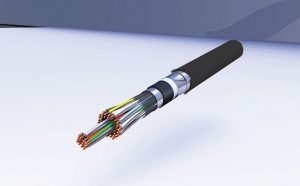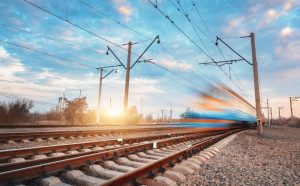Maybe millions of users of different products and services do not even think about what the cable industry means for everyone…Simply: is a network that powers everything around us. The energy, data and all the “connection” means are part of our life and are essential to our future which is rapidly re-shaped.
Taking action to fight climate change, the reduction of the impact on the environment, creating sustainable energy and transport that meet the demands are huge challenges but at the same time they bring new opportunities. Nexans is able to answer these challenges by providing products and solutions with a low environmental impact and is constantly involved in research and development activities to reinforce its technological leadership and to deliver high-quality products.
Transport is a strategic sector for the economy and our mobility, and a deep transformation is mandatory as it must support the reduction of the environmental impact. At the same time, the digital transformation is already taking place and is essential for our connectivity and smart transport system. As rail is the most environmentally friendly transport mode, it must be further developed and needs to be supported from the ‘cable network’ to the physical infrastructure. Thus, Nexans selected this transport mode as a priority and is on its way to mix its development, production and products to meet the changing demands.
 Dumitru Sirbu, Nexans Business Manager Central and Eastern Europe explains to our readers the vital role the cable industry represents for our society, the projects that contribute towards a safe and innovative transport sector, the challenges ahead and the way they can be tackled.
Dumitru Sirbu, Nexans Business Manager Central and Eastern Europe explains to our readers the vital role the cable industry represents for our society, the projects that contribute towards a safe and innovative transport sector, the challenges ahead and the way they can be tackled.
Nexans brings life to the energy by offering a wide range of cables and cabling solutions that transmit the power and information to the final client – people, communities, authorities, industry, etc. Although it is a hidden network, the cables give power to everything around us. Would you provide us an overview of what the cable industry means to billions of users?
Seldom seen but omnipresent, the cables and cabling systems are everywhere in our daily modern life. 3 to 5 km of cables in a car / 650 km in a plane / 1,500 km on an oil rig / 3,000 km in a cruise ship / 15 to 30 km of cables in a 1500 sqm. building / 1750 km of submarine cables for an offshore wind farm. As the leading manufacturer of cables worldwide, Nexans is indeed at the heart of the major economic challenges at stake in this coming century: the mastering of energy and raw materials, the interconnection of large infrastructure networks, the transformation of transport, the increasing impact of telecommunications to name but a few. For all this, you need cables.
Nexans Group has industrial presence in 34 countries with over 26,000 employees and sales of around EUR 6.5 billion in 2019.
Nexans quickly adapts to new innovative demands and has contributed and continues to do so to the evolution of the world we live in. In general terms, how does Nexans view the concept of critical connectivity for the business, infrastructure and the transport system – one of the most important sectors for our economy and mobility?
In a rapidly transforming world that is increasingly reliant on connectivity, Nexans is well-placed to capitalize on developing opportunities. Several interlinked megatrends such as energy transition, digital revolution and global mobility all hold vast potential.
Anticipating customer needs, we are preparing today to meet future customer challenges in four key sectors:
High voltage and Projects
Continuing to grow in the subsea cabling business while improving high-voltage land cabling competitiveness, helping customers find the most efficient and reliable cable solution.
Building and Territories
Providing new smart solutions for buildings, cities and regions to become more sustainable in e-mobility and energy transition.
Industry and Solutions
Partnering with Original Equipment Manufacturers (OEMs) to develop customised cabling and connectivity solutions for power, data transmission and automation needs.
Telecom and Data
Supporting customers in selecting the right optical fibre infrastructure, including submarine backbones, and providing ‘plug-and-play’ cable and connectivity solutions, with a specific offer for hyperscale data centres.
 Innovation is the word for a constantly changing world, and Nexans is the vital bond for energy and data evolution. How does Nexans respond to the mega-trends through research and innovation?
Innovation is the word for a constantly changing world, and Nexans is the vital bond for energy and data evolution. How does Nexans respond to the mega-trends through research and innovation?
Our customers can count on us for extensive and productive research which enables us to continuously sharpen our technological edge, provide solutions that meet safety, energy efficiency and environmental challenges, and anticipate changes in industrial standards. We have a Scientific Committee which is open to scientists from outside the Group and whose responsibilities include identifying new technologies that can create value for our customers. In parallel, our leading experts drive Nexans’ research and innovation capabilities forward in areas that are crucial for reinforcing our technological leadership.
We forge tight-knit relationships with our customers. For example, our application centres are open to customers to test and compare cable performance under real operating conditions. Several major customers use our engineers within their own R&D teams to learn from them when working on shared projects.
The decarbonisation and carbon neutrality have led to new strategies for individual companies, authority and country establishing the concept of sustainability. How does Nexans address these challenges through new products and services?
World energy demand is expected to increase by a third between now and 2035. The challenge going forward will therefore be to develop cost-efficient and durable energy resources while maintaining the highest levels of safety and environmental protection. Nexans’ solutions are well-known for their effectiveness and reliability in areas that are difficult to access, such as mines, oil and gas fields, and off-shore wind farms, all of which are becoming increasingly deep or remote. Additionally, the solutions designed by our teams facilitate the development of renewable energies.
Whatever their chosen means of transport – car, plane, ship, train or metro – today’s travellers want systems that are safe, reliable, compact and lightweight and that offer on-board communications. Both light and recyclable, Nexans’ cables and harnesses contribute to the development of ever-safer and environmentally-friendly means of transport. Our fire-resistant cables, allied with our state-of-the-art signalling systems, make transport more reliable, and our electrical connection cables for ships and planes reduce CO2 emissions in ports and airports.
We seek to satisfy our customers by providing products and solutions that have a lower environmental impact throughout their life cycle. We are constantly on the lookout for ways to improve our machinery, business practices and processes in order to reduce our use of resources, our emissions and the waste we produce. We continuously assess and compare our performance to identify the best options and then roll these out Group-wide. As a pioneer in recycling, we have put in place a comprehensive solution for recycling and reusing cables at the end of their lives in order to offer our customers solutions that create shared value.
We are taking steps to increase our “green” purchases and improve the environmental footprint of our supply chain by focusing on energy and vehicles that emit less CO2 as well as on more energy-efficient industrial engines and eco-certified packaging and cable drums. Ready-to-lay cables, grouped deliveries, multimodal transport solutions, and the reuse of drums are all ways in which we can cut down on over-consumption and CO2 emissions.
 When talking about electricity, transport is one of the major sectors that need a comprehensive transformation to become sustainable and to contribute to emissions’ reduction because it is one of the biggest emitters of greenhouse gas emissions. How does Nexans support the original equipment manufacturers and infrastructure projects through the solutions and services is offering?
When talking about electricity, transport is one of the major sectors that need a comprehensive transformation to become sustainable and to contribute to emissions’ reduction because it is one of the biggest emitters of greenhouse gas emissions. How does Nexans support the original equipment manufacturers and infrastructure projects through the solutions and services is offering?
Innovation is no longer an option for industry. Digital transformations, a growing regulatory environment and profitability require rethinking traditional business and technology approaches to help sustainable performance. This is why Nexans has developed a unique programme of services to support the operational and financial performance for industrial operators. A programme based on engineering, digital, innovation, business and logistical expertise. A leading know how to cope with your future industrial challenges. For rolling stock, Nexans can provide customised solutions from engineering to supply chain and to recycling. In each step of the rolling stock process Nexans engineers help performance of its partners. We are offering dedicated services in three areas:
- Supply Chain and Operations
- Engineering of electrical cabling
- Business Support
We would like you to outline the successful projects you have led and what they meant for Nexans.
For Nexans Romania, a small but enthusiastic team of professionals is responsible for the management, identification of the right channels and the projects in twelve countries in Central and South-Eastern Europe. Based on Nexans wide range of products, we are in the position to deliver specialised cables according to customer requirements, offering tailored solutions for specific applications within the scope of any client project.
If we refer strictly to the projects related to public transport (trams, trolleys or metro), together with our local partners we succeeded in:
– the rehabilitation of tram lines in Bucharest (41, 35 and others), where we delivered the DC feeding cables of the contact wire catenary network, from the rectifier stations to the connection boxes on the poles supporting the contact wire, but also the cables for the flexible connections between the connection boxes and the contact wire;
– the participation to the tram modernization programme in Bucharest, where we delivered our dedicated range of flexible, halogen-free rolling stock cables;
– supply of DC cables for trolleybus lines in Galati city;
– Metrorex projects: supply of halogen-free cables (Low Smoke Zero Halogens), fire resistant, screened cables, all having low emission of smoke and corrosive gases when affected by fire, for metro transport, for DC applications, low and medium voltage, signalling, fiber optic cables, ticketing systems. We have delivered such cables to the metro, either entirely or partially, for all the modernization works or new investments carried out by Metrorex, from 2004 till today;
– Rail transport projects: we have delivered rail and energy signalling cables for the pan-European transport corridor IV, for two of the three sections on Bucharest-Constanta route, Bucharest-Campina, Curtici-Arad sections. For sections in the western part of the country, on the same corridor, we also delivered fibre optic cables and also axle count cables;
– Bulgaria: we have delivered signalling quad cables (designs similar to DB) for railway rehabilitation projects;
– Serbia: we have delivered signalling cables (designs similar to DB) for various projects in Serbia, as well as telecommunication cables with paper insulation.
 What are the projects Nexans is currently working on in this region of Europe and what can you tell us about future opportunities?
What are the projects Nexans is currently working on in this region of Europe and what can you tell us about future opportunities?
We closely follow all future projects of new metro lines in Bucharest and we are ready to participate with our cabling solutions.
In Bulgaria, we have an order in progress targeting the repair works of the signalling installations of the Bulgarian railway, and the cables to be delivered are in quad construction, similar to DB design. We also aim to participate in the current projects for the rehabilitation of the Bulgarian railway, with EC funds, where we estimate that deliveries will start in the second half of next year.
In Croatia, for a project under way for the upgrading of 50 level crossings over the railway, we have already carried out the first delivery of signalling quad cable (DB design), and the second batch will be delivered next year.
In Serbia, the works on the new railway had been halted due to the pandemic. We estimate that the works will resume in the next year, and we will deliver our signalling quad cables and telecommunications cables with paper insulation, which are already well-known in this country.
In what way do you address the projects’ challenges from concept to on-time delivery and how the company responds to deliver a high service and product quality?
Nexans has selected railways as a priority market segment and we are currently combining our development, marketing and production resources around the world to meet the changing demands of the railway industry which now operates on an increasingly global scale.
The performance and safety of the railway infrastructure and the rolling stock commences from an efficient infrastructure based on cables and cabling solutions and systems for energy, telecommunication, signalling and data… What does this mean for the clients?
Rail transport is very dependent on the quality of the infrastructure that supports it, and that includes cables and cabling systems for telecommunications and energy. Modern high-speed trains demand cables with different characteristics in terms of bandwidth, safety, electromagnetic immunity and resistance.
Safety has become a prime concern for the world’s rail operators, and there is a demand not only for more reliable operating systems, but also for materials with improved fire-performance characteristics, especially in tunnels, stations and public areas. Urban mass transit, subways, fully-automated metros, light rail suburban lines and trams are experiencing substantial growth. Each rail mode has its own cable needs.
What railway operators expect of a cable manufacturer
– Range of high-quality cables from one supplier;
– Mastery of energy, data and radio-based technologies;
– Installation for mainline, mass transit, tunnels, right-of-ways, etc.;
– Enhanced fire performance for public and infrastructure safety;
– Interoperability, open standards, and worldwide compliance;
– Cable efficiency, compactness, lightness, and resistance;
– Low costs, minimum maintenance, easy upgrades.
To answer these challenges, Nexans provides a complete range of cables and accessories for all of your railway networks projects.
What is the message you are sending to the rail industry particularly in the Central and South-Eastern Europe region at a stage that requires investments and is trying to bridge the gap with Western countries, while at the same time focusing on performance and quality?
Nexans wants to be part of current changes, by playing a role beyond cable. During its half-century of involvement in the rail industry, the company has gained valuable experience by working closely with rolling stock engineers and operators always finding solutions which respect their many priorities, from concerns of cost, efficiency and safety, to wider issues of reducing CO2 emissions.
Share on:



